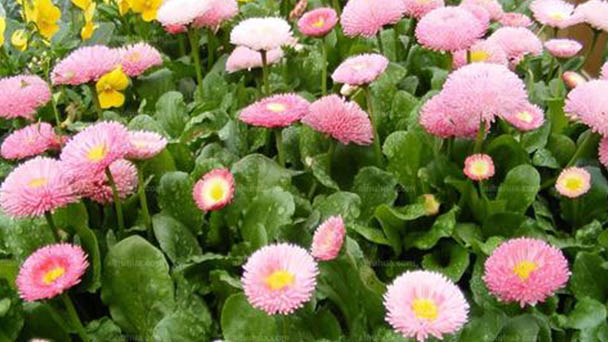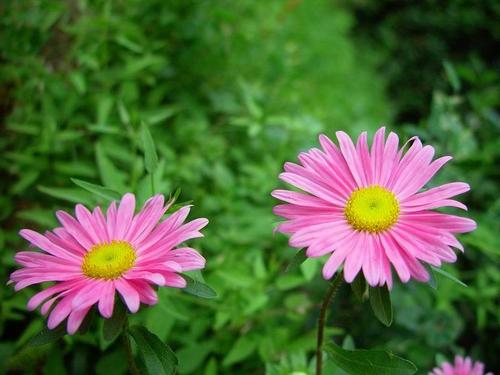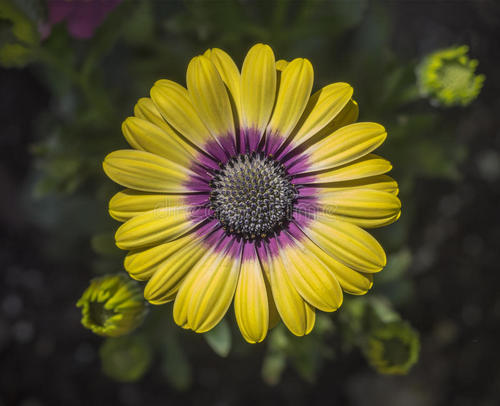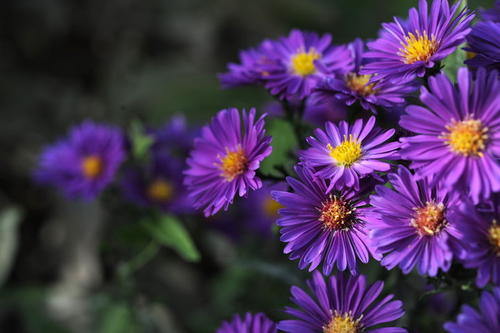Callistephus chinensis (China aster) profile
Written by Maggie
Feb 26 2021

China aster (Callistephus chinensis (L.) Nees) belongs to Compositae and China aster genus. China aster is an Asteraceae herb. Many cultivars have long been used as ornamental flowers in gardens.
China aster picture

Morphological characteristics of China aster
Stems
China aster is an annual or biennial herb with a height of (15) 30-100 cm. Stems are erect, solitary, longitudinally ribbed, white strigose, 6-7 mm in diameter at base, or slender to 1 mm, branches obliquely ascending or unbranched.
Leaf
The lower stems and leaves of china aster fall off or survive at the flowering stage; Middle stem and leaves are ovate, rhomboid ovate or spatulate or suborbicular, 2.5-6 cm long, 2-4 cm wide, apically acuminate, basally truncate, cuneate or rounded, margin irregularly coarsely serrated, sparsely bristled on both sides, petiole 2-4 cm long, white bristled, with narrow wings; Stems and leaves of China aster are distally tapered, rhombicular lanceolate, oblong or oblanceolate, margin 1-2 serrate, or linear and entire.
Flowers
China aster head is solitary, 6 -- 8 cm in diameter, long pedunculate. Involucral bracts are hemispherical, 2-5 cm wide; Involucral bracts are 3-ply, subequal, outer layers oblong-lanceolate or spatulate, leaves, 1-2.4 cm long, 2-4 mm wide, tip obtuse, margin with long white eyelashes, middle spatulate, shorter, thinner, purplish, inner bracts oblong, membranous, translucent, tip obtuse. Female flowers of China aster are 1 layer, may be multilayer in circular culture, red, reddish, blue, yellow, or bluish purple, ligulate 2.5 -- 3.5 cm long, 2 -- 7 mm wide, with short tubes 2 -- 3 mm long; Bisexual flowers of China aster are yellow corolla, eaves 4-7 mm long, tube 1-1.5 mm long.
Fruit
Achene of China Aster is oblateolate, slightly oblate, 3 -- 3.5 mm long, and above middle. The outer canopy is persistent, the inner canopy is snowy white, unequal in length, 3-4.5 mm long, the tip acuminate, easy to fall off.
Ecological habits of China aster
China aster likes warm, humid and sunny conditions. China aster fears of high temperature, humidity and poor ventilation. China aster is weakly cold tolerant, also does not like heat, ventilation and is full of sunshine when the growth is exuberant.
The optimum temperature for the growth of China aster is 15 ~ 25℃, and the temperature in winter is not lower than 3℃. If 0℃ below the stem and leaf vulnerable to freezing damage. On the contrary, when the summer temperature exceeds 30℃, flowering is delayed or poor. China aster is a shallow-rooted plant, so it is necessary to keep the soil moist during the growth process to facilitate the growth of stem and leaves. At the same time, over wet soil in the basin has a greater effect on China as it causes barren growth, lodging and diseases. China aster is a long - day plants, sensitive to sunlight, 15 hours a day long sunshine conditions, keep plants short, flowering can be earlier.If short - day treatment, plants grow tall, late flowering vertebra.
China aster prefers fertile, moist and well-drained loam and sandy loam. Roots are easy to rot and die when standing water.Flowers bloom in summer and fall.
Growing methods of China aster
China aster is often sown to reproduce. Sowing time is determined by variety and application requirements. Take the asteroid series of potted varieties. China aster has 420 ~ 430 seeds per gram, the optimum temperature for germination is 18 ~ 21℃, and germinates 7 ~ 21 days after sowing. Seedlings grow quickly and should be thinned out in time. With fully mature high quality organic fertilizer as base fertilizer, chemical fertilizer can be used as topdressing, generally more spring sowing, but also summer and autumn sowing, sowing after 2 to 3 months can blossom.
China aster seedlings should be thinned in time after emergence. After a transplanting, the seedlings should be planted when the height is 10 cm. Frequent irrigation is needed in the dry summer. China aster for autumn planting cut flowers must be illuminated for 1 to 2 hours in the middle of the night to promote stem elongation and flowering. China aster does not usually need to be taken for granted.In order to make the inflorescences on the main branches fully show the variety characteristics, a part of the lateral branches should be properly cut, and 5-7 flower branches should be retained per plant. China aster is transplanted once 15 ~ 20 days after seedling emergence, and transplanted in pots after 40 ~ 45 days of growth, usually in pots of 10 ~ 12 cm. Fertilizer 1 time per ten days in the growing period, also can be used "Hui You "20-20-20 general fertilizer. Potted 45 ~ 80 days after the application of phosphate and potassium fertilizer once. China aster is a common outcrossing plant. The natural cross rate of the double-petal variety is very low, and it is easy to maintain the good characteristics of the variety. The varieties with low double petals have high natural hybridization rate and must be isolated when keeping seeds.
Disease control of China aster
China aster xanthosis
China Aster Xanthosis is an important disease of China Aster. The infected plant is short, atrophic, and the flowers are small and discolored.
Symptoms
After the disease, the leaves of China aster are light yellow, often grow from beginning to end brush-like bushsticks, bushsticks on the flower color have different degrees of fading, petals are usually light yellow green.Plants grow weakly and can continue to infect neighboring plants.
Pathogen
China aster xanthosis is caused by mycoplasmid (MLO) infection. The mycoplasts mainly survive on various perennial hosts, such as Daisy, celadon, celadon, etc.Mainly through leafhoppers, dodder, such as transmission.
Method of prevention and cure
The best control method is to plant species in the net room.
We can spray 50% marathon 1000 times liquid or diazinon and other insecticide control leafhoppers.
3. The wild weeds around China aster should be removed regularly to reduce the source of infection.
4. The early stage of the disease, spraying medical tetracycline or oxytetracycline 4000 times liquid.
China aster grey mould
The disease was identified as Botrytis cinerea Pers. The pathogen nucleus overwinters on the residual body or in the soil. When the temperature is about 20℃, humidity is very large, prone to this disease. Plastic greenhouses are more serious than glass greenhouses. China aster is a common disease that damages flowers, pedicels and leaves. Severe, flowers, leaves are dead, affecting its ornamental. When the leaves are affected, the yellow-green or dark green spots appear initially in the form of water stains, and then the spots gradually expand. When the environment is relatively humid, they cause rot and gray powdery spore layers appear on the leaves. The diseased leaves eventually wither.Petals may be susceptible to the disease in the bud or after opening. At first, the edges of the petals appear to be pale brown water stains, as well as decay.
Method of prevention and cure
Pay attention to greenhouse ventilation, reduce humidity, avoid inappropriate watering.Remove the diseased plant and leaf in time to reduce the infection source.
The onset of spray 50% speed Kalin WP 1500 times liquid or 50% pouhain 1500 times liquid.

Species classification of China aster
Common varieties of China Aster are:
The Asteroid Series
Plant height 25 cm, chrysanthemum type, flower diameter 10 cm, dark blue, bright red, white, rose red, light blue and other colors, from sowing to flowering 120 days.
DwarfQueen series
Plant height 20 cm, double petals, flower diameter 6 cm, flowers bright red, dark blue, rose pink, light blue, red, etc., from sowing to flowering takes 130 days.
The Minilady series
Plant height 15 cm, spherical type, color has rose red, white, blue and so on.
The Potn 'Patio collection
Plant height 10 ~ 15 cm, double petals, flower diameter 6 ~ 7 cm, color blue, pink, red, white, etc., from sowing to flowering only 90 days.
Dwarfwaldersee
Plant height 20 cm, compact flowers, color has dark yellow, pure white, blue, pink and so on.
Carpetball
Plant height 20 cm, spherical type, color white, red, purple, pink, purple and so on.
The Comet series
Plant height 25 cm, big flowers, double petals, like marigold, flower diameter 10 ~ 12 cm, there are 7 kinds of colors.
Lady (Milady)
Plant height 20 cm, cold resistant, resistant to wilt varieties.
Moraketa
Plant height 20 cm, flowers beige, weather - resistant.
Pruhonicer
Plant height 25 cm, tongue - shaped flowers slightly open, like the head, flower diameter 3 cm.Puppet, plant height 15 ~ 20 cm, multi - flower, flower like small chrysanthemum, design and color.Ladies series, strong branching, double petals, large flowers, 7 cm diameter.The above varieties are suitable for potted ornamental.
The distribution region of China aster
China aster is produced in Jilin, Liaoning, Hebei, Shanxi, Shandong, Yunnan and Sichuan provinces in China. China aster grows in hillside hold up waste land, hillside grass, water edges or sparse forest shade. 30-2700 meters above sea level. China aster is often referred to as ornamental planters in botanical gardens, gardens, courtyards and other public places.
China aster is widely cultivated and wild in Japan and Korea. The botanical gardens of the Soviet Union and other countries in Europe have been introduced for ornamental flowers.
The use of China aster in gardens
Ornamental value
China aster is a very important ornamental plant in horticultural field at home and abroad.Internationally, dwarf species are used for potted plants and flower beds, while tall culm species are used for cut flowers. China aster is mainly used in potted plants and gardens in China, and has become one of the most important potted flowers.
Landscaping
Many cultivars of China aster have been used as ornamental flowers in gardens for a long time. China aster has bright color, diverse flower types, abundant flowering and long flowering period. China aster is a highly valued ornamental plant in horticultural circles at home and abroad. China Aster is originally from the north of China. Many flower companies in many countries are engaged in the breeding and production of China Aster, and have bred many new varieties, making China Aster become one of the important grass flowers in the European flower market. In Asia, Japanese seed companies also breed a lot of good varieties of China aster, so that China aster occupies a certain share in Japanese grass flowers.
China aster flower language
China aster flower language: worry about your love, my love is deeper than yours, think of reliable love, please believe me.

Latest Updated
- Benefits of Bugleweed - 7 Science-backed Health Benefits
- Bugleweed Dangers & Side Effects - Is It Poisonous?
- How to Plant Evergreen Trees - What You Should Know
- When to Plant Evergreens - Grow Guide for Evergreen Trees
- 12 Wonderful Evergreen Shrubs for Your Garden
- 12 Popular Evergreen Plants with Pictures for Beginners
- When And How To Prune A Lilac Bush Like a Pro
- How to Grow & Care for Lilac Vine (Hardenbergia Violacea)
- Japanese Lilac Tree (Syringa Reticulata) Care & Propagation Guide
- Shumard Oak Pros and Cons - What to Know
Popular Articles
- Winter maintenance of Antirrhinum Majus
- How to Grow Terminalia Mantaly Tree
- How to Grow and Care for Crossostephium Chinense
- How to grow Antirrhinum Majus in spring
- Peristeria Elata (Dove Orchid) Profile: Info & Care Guide
- Underwatered Snake Plant (Sansevieria Trifasciata) - Signs And How To Fix
- How to Care for Brazilian Jasmine Plant (Mandevilla Sanderi)
- How to Grow & Care for Graptopetalum Purple Delight in Summer
- Rosa Chinensis (China Rose): Plant Growing & Care Tips
- How to Care for Baby Sun Rose (Aptenia Cordifolia)